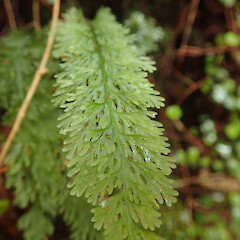Abrodictyum strictum
Common name
erect bristle fern
Synonyms
Trichomanes strictum Menzies ex Hook. et Grev.; Macroglena stricta (Hook. et Grev.) Copel.; Trichomanes leptophyllum A.Cunn.; Trichomanes rigidum var. strictum (Menzies ex Hook. et Grev.) Field,
Family
Hymenophyllaceae
Flora category
Vascular – Native
Endemic taxon
No
Endemic genus
No
Endemic family
No
Structural class
Ferns
NVS code
The National Vegetation Survey (NVS) Databank is a physical archive and electronic databank containing records of over 94,000 vegetation survey plots - including data from over 19,000 permanent plots. NVS maintains a standard set of species code abbreviations that correspond to standard scientific plant names from the Ngä Tipu o Aotearoa - New Zealand Plants database.
TRISTR
Current conservation status
The conservation status of all known New Zealand vascular plant taxa at the rank of species and below were reassessed in 2017 using the New Zealand Threat Classification System (NZTCS) – more information about this can be found on the NZTCS website. This report includes a statistical summary and brief notes on changes since 2012 and replaces all previous NZTCS lists for vascular plants.
Please note, threat classifications are often suggested by authors when publications fall between NZTCS assessment periods – an interim threat classification status has not been assessed by the NZTCS panel.
- Conservation status of New Zealand indigenous vascular plants, 2017 . 2018. Peter J. de Lange, Jeremy R. Rolfe, John W. Barkla, Shannel P. Courtney, Paul D. Champion, Leon R. Perrie, Sarah M. Beadel, Kerry A. Ford, Ilse Breitwieser, Ines Schönberger, Rowan Hindmarsh-Walls, Peter B. Heenan and Kate Ladley. Department of Conservation. Source: NZTCS and licensed by DOC for reuse under the Creative Commons Attribution 4.0 International licence.
2017 | Not Threatened
Previous conservation statuses
2012 | Not Threatened
2009 | Not Threatened
2004 | Not Threatened
Distribution
Endemic. New Zealand: North Island (from Te Paki south), South Island, Stewart Island/Rakiura and Chatham Islands. Mainly westerly on the two main islands of New Zealand. Extremely uncommon on the Chatham Islands where it is known only from two sites on Chatham Island (Rēkohu).
Habitat
Coastal to montane, in closed forest (at usually (but not exclusively) at higher elevations in the North Island), often in tree caves, and amongst exposed tree roots, in and around rock overhangs, cave entrances, and within pot holes in ephemeral streams, or on mossy logs and moss covered banks and ledges within stream systems. Occasionally on clay banks in gumland scrub.
Detailed description
Terrestrial tufted fern. Rhizomes short, stout, erect, bearing numerous red-brown hairs. Fronds dark green, ± erect, arcuate. Stipes 30–140 mm long. Rachises narrowly winged throughout. Laminae 60–200(–220) × 20–60 mm, narrowly elliptic, 3-pinnate, somewhat stiff and bristly. Primary and secondary pinnae stalked, imbricate; ultimate segments linear, each furnished with a single unbranched vein. Sori present near bases of lamina segments, stalked on short branches, several on each primary pinna. Indusia tubular, mouth slightly flared, receptacle exserted.
Similar taxa
Easily distinguished from other New Zealand members of Abrodicytum species by the short, erect rhizomes, and long, narrow rather stiff and bristly fronds with finely divided linear ultimate segments. Most often confused with young plants of the very different Leptopteris hymenophylloides from which it can be distinguished by the tubular indusia bearing hair-like exserted receptacles.
Propagation technique
Difficult—should not be removed from the wild.
Threats
Not Threatened. However, this species is biologically sparse and possibly merits listing as ‘At Risk-Naturally Uncommon’ with the qualifier “Sp” [Sparse].
Etymology
abrodictyum: From the Greek habros ‘delicate’, ‘pretty’ and diktyon ‘net’, literally “delicate net”
strictum: From the Latin strictus ‘upright, stiff’
Where To Buy
Not commercially available
Taxonomic Notes
NZPCN now follows Ebihara et al. (2006) in recognising Abrodictyum as distinct from Trichomanes. Although Brownsey & Perrie (2016) rejected this idea, the generic segregation was adopted by the PPG I (2016) and is now widely followed throughout the world.
Attribution
Fact sheet prepared for NZPCN by P.J. de Lange (21 April 2011). Description adapted from Brownsey & Smith-Dodsworth (2000).
References and further reading
Brownsey PJ, Smith-Dodsworth JC. 2000. New Zealand Ferns and Allied Plants. David Bateman, Auckland, NZ. 168 p.
Brownsey PJ, Perrie LR. 2016. Hymenophyllaceae. In: Breitwieser I, Heenan PB, Wilton AD. Flora of New Zealand - Ferns and Lycophytes. Fascicle 15. Manaaki Whenua Press, Lincoln, NZ. https://doi.org/10.7931/B1QP4Z.
Ebihara A, Dubuisson, J-Y, Iwatsuki K, Hennequin S, Ito M. 2006. A taxonomic revision of the Hymenophyllaceae. Blumea 51: 2–57. https://doi.org/10.3767/000651906X622210.
PPG 1: The Pteridophyte Phylogeny Group 2016. A community-derived classification for extant lycophytes and ferns. Journal of Systematics and Evolution 54: 563–603. https://doi.org/10.1111/jse.12229.
NZPCN Fact Sheet citation
Please cite as: de Lange, P.J. (Year at time of access): Abrodictyum strictum Fact Sheet (content continuously updated). New Zealand Plant Conservation Network. https://www.nzpcn.org.nz/flora/species/abrodictyum-strictum/ (Date website was queried)







